动词不定式讲解
- 格式:doc
- 大小:50.00 KB
- 文档页数:7
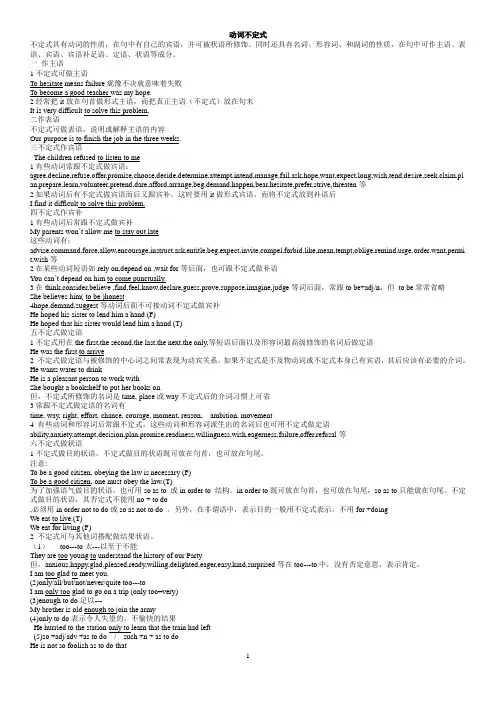
动词不定式不定式具有动词的性质,在句中有自己的宾语,并可被状语所修饰。
同时还具有名词、形容词、和副词的性质,在句中可作主语、表语、宾语、宾语补足语、定语、状语等成分。
一作主语1不定式可做主语To hesitate means failure犹豫不决就意味着失败To become a good teacher was my hope.2经常把it放在句首做形式主语,而把真正主语(不定式)放在句末It is very difficult to solve this problem.二作表语不定式可做表语,说明或解释主语的内容Our purpose is to finish the job in the three weeks.三不定式作宾语The children refused to listen to me1有些动词常跟不定式做宾语:agree,decline,refuse,offer,promise,choose,decide,determine,attempt,intend,manage,fail,ask,hope,want,expect,long,wish,tend,desire,seek,claim,pl an,prepare,learn,volunteer,pretend,dare,afford,arrange,beg,demand,happen,bear,hesitate,prefer,strive,threaten等2如果动词后有不定式做宾语而后又跟宾补,这时要用it做形式宾语,而将不定式放到补语后I find it difficult to solve this problem.四不定式作宾补1有些动词后常跟不定式做宾补My parents won’t allow me to stay out late这些动词有:advise,command,force,allow,encourage,instruct,ask,entitle,beg,expect,invite,compel,forbid,like,mean,tempt,oblige,remind,urge,order,want,permi t,wish等2在某些动词短语如rely on,depend on ,wait for等后面,也可跟不定式做补语You can’t depend on him to come punctually.3在think,consider,believe ,find,feel,know,declare,guess,prove,suppose,imagine,judge等词后面,常跟to be+adj/n,但to be常常省略She believes him( to be )honest4hope,demand,suggest等动词后面不可接动词不定式做宾补He hoped his sister to lend him a hand (F)He hoped that his sister would lend him a hand (T)五不定式做定语1不定式用在the first,the second,the last,the next,the only,等短语后面以及形容词最高级修饰的名词后做定语He was the first to arrive2 不定式做定语与被修饰的中心词之间常表现为动宾关系,如果不定式是不及物动词或不定式本身已有宾语,其后应该有必要的介词。
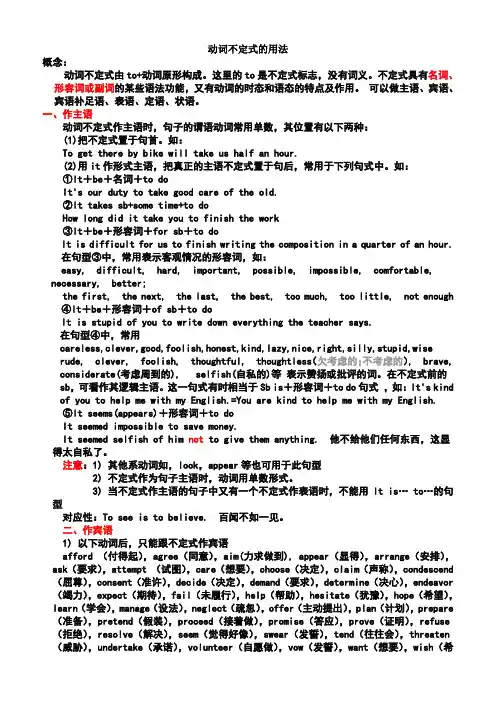
动词不定式的用法概念:动词不定式由to+动词原形构成。
这里的to是不定式标志,没有词义。
不定式具有名词、形容词或副词的某些语法功能,又有动词的时态和语态的特点及作用。
可以做主语、宾语、宾语补足语、表语、定语、状语。
一、作主语动词不定式作主语时,句子的谓语动词常用单数,其位置有以下两种:(1)把不定式置于句首。
如:To get there by bike will take us half an hour.(2)用it作形式主语,把真正的主语不定式置于句后,常用于下列句式中。
如:①It+be+名词+to doIt's our duty to take good care of the old.②It takes sb+some time+to doHow long did it take you to finish the work③It+be+形容词+for sb+to doIt is difficult for us to finish writing the composition in a quarter of an hour.在句型③中,常用表示客观情况的形容词,如:easy, difficult, hard, important, possible, impossible, comfortable, necessary, better;the first, the next, the last, the best, too much, too little, not enough④It+be+形容词+of sb+to doIt is stupid of you to write down everything the teacher says.在句型④中,常用careless,clever,good,foolish,honest,kind,lazy,nice,right,silly,stupid,wise rude, clever, foolish, thoughtful, thoughtless(欠考虑的;不考虑的), brave, considerate(考虑周到的), selfish(自私的)等表示赞扬或批评的词。

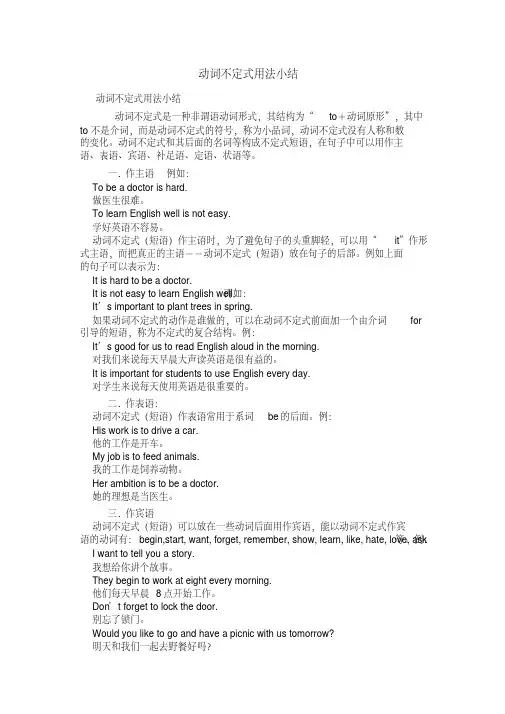
动词不定式用法小结动词不定式用法小结动词不定式是一种非谓语动词形式,其结构为“to+动词原形”,其中to不是介词,而是动词不定式的符号,称为小品词,动词不定式没有人称和数的变化。
动词不定式和其后面的名词等构成不定式短语,在句子中可以用作主语、表语、宾语、补足语、定语、状语等。
一. 作主语例如:To be a doctor is hard.做医生很难。
To learn English well is not easy.学好英语不容易。
动词不定式(短语)作主语时,为了避免句子的头重脚轻,可以用“it”作形式主语,而把真正的主语--动词不定式(短语)放在句子的后部。
例如上面的句子可以表示为:It is hard to be a doctor.再如:It is not easy to learn English well.It’s important to plant trees in spring.如果动词不定式的动作是谁做的,可以在动词不定式前面加一个由介词for 引导的短语,称为不定式的复合结构。
例:It’s good for us to read English aloud in the morning.对我们来说每天早晨大声读英语是很有益的。
It is important for students to use English every day.对学生来说每天使用英语是很重要的。
二. 作表语:动词不定式(短语)作表语常用于系词be的后面。
例:His work is to drive a car.他的工作是开车。
My job is to feed animals.我的工作是饲养动物。
Her ambition is to be a doctor.她的理想是当医生。
三. 作宾语动词不定式(短语)可以放在一些动词后面用作宾语,能以动词不定式作宾等。
例:语的动词有:begin,start, want, forget, remember, show, learn, like, hate, love, askI want to tell you a story.我想给你讲个故事。
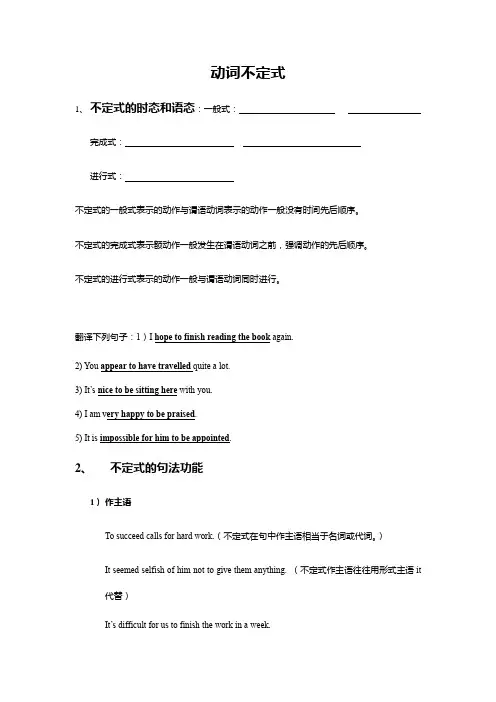
动词不定式1、不定式的时态和语态:一般式:完成式:进行式:不定式的一般式表示的动作与谓语动词表示的动作一般没有时间先后顺序。
不定式的完成式表示额动作一般发生在谓语动词之前,强调动作的先后顺序。
不定式的进行式表示的动作一般与谓语动词同时进行。
翻译下列句子:1)I hope to finish reading the book again.2) You appear to have travelled quite a lot.3) It’s nice to be sitting here with you.4) I am v ery happy to be praised.5) It is impossible for him to be appointed.2、不定式的句法功能1)作主语To succeed calls for hard work.(不定式在句中作主语相当于名词或代词。
)It seemed selfish of him not to give them anything. (不定式作主语往往用形式主语it 代替)It’s difficult for us to finish the work in a week.2)作宾语不定式一般作动词的宾语,不直接作介词的宾语,但“疑问词+不定式”结构可以作介词的宾语。
如:Y our father has at last decided to quit smoking.Talk with friends about where to shop.只接to do 作宾语的常见动词有:afford, agree, arrange, ask, care, choose, decide, demand, determine, expect, help, hope, plan, hesitate, long, manage, offer, prepare, refuse, pretend, promise, want, intend ,prefer3)作表语,可以表示主语的具体内容,目的。
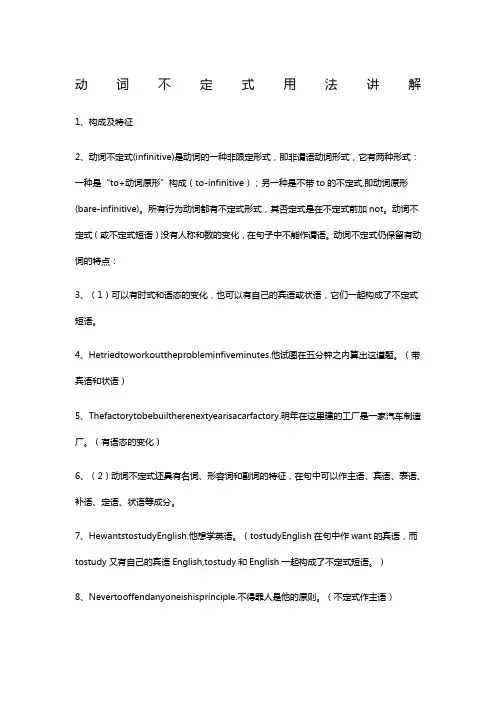
动词不定式用法讲解1、构成及特征2、动词不定式(infinitive)是动词的一种非限定形式,即非谓语动词形式,它有两种形式:一种是“to+动词原形”构成(to-infinitive);另一种是不带to的不定式,即动词原形(bare-infinitive)。
所有行为动词都有不定式形式,其否定式是在不定式前加not。
动词不定式(或不定式短语)没有人称和数的变化,在句子中不能作谓语。
动词不定式仍保留有动词的特点:3、(1)可以有时式和语态的变化,也可以有自己的宾语或状语,它们一起构成了不定式短语。
4、Hetriedtoworkouttheprobleminfiveminutes.他试图在五分钟之内算出这道题。
(带宾语和状语)5、Thefactorytobebuiltherenextyearisacarfactory.明年在这里建的工厂是一家汽车制造厂。
(有语态的变化)6、(2)动词不定式还具有名词、形容词和副词的特征,在句中可以作主语、宾语、表语、补语、定语、状语等成分。
7、HewantstostudyEnglish.他想学英语。
(tostudyEnglish在句中作want的宾语,而tostudy又有自己的宾语English,tostudy和English一起构成了不定式短语。
)8、Nevertooffendanyoneishisprinciple.不得罪人是他的原则。
(不定式作主语)9、注意:不定式在许多场合具有情态意义。
作主语时,相当于一个带有情态动词的主语从句;作宾语时,相当于一个带有情态动词的宾语从句;作定语时,相当于一个带有情态动词的定语从句;作目的状语时,相当于sothat或inorderthat引导的目的状语从句。
10、Itisrightforhertosayso.(=Itisrightthatsheshouldsayso.)她这样说是对的。
11、Hehasalotofworktodo.(=…thatheshoulddo)他有很多工作要做。
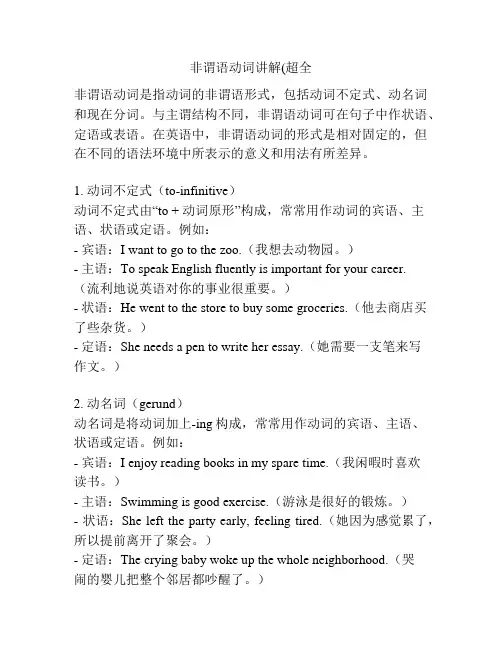
非谓语动词讲解(超全非谓语动词是指动词的非谓语形式,包括动词不定式、动名词和现在分词。
与主谓结构不同,非谓语动词可在句子中作状语、定语或表语。
在英语中,非谓语动词的形式是相对固定的,但在不同的语法环境中所表示的意义和用法有所差异。
1. 动词不定式(to-infinitive)动词不定式由“to + 动词原形”构成,常常用作动词的宾语、主语、状语或定语。
例如:- 宾语:I want to go to the zoo.(我想去动物园。
)- 主语:To speak English fluently is important for your career.(流利地说英语对你的事业很重要。
)- 状语:He went to the store to buy some groceries.(他去商店买了些杂货。
)- 定语:She needs a pen to write her essay.(她需要一支笔来写作文。
)2. 动名词(gerund)动名词是将动词加上-ing构成,常常用作动词的宾语、主语、状语或定语。
例如:- 宾语:I enjoy reading books in my spare time.(我闲暇时喜欢读书。
)- 主语:Swimming is good exercise.(游泳是很好的锻炼。
)- 状语:She left the party early, feeling tired.(她因为感觉累了,所以提前离开了聚会。
)- 定语:The crying baby woke up the whole neighborhood.(哭闹的婴儿把整个邻居都吵醒了。
)3. 现在分词(present participle)现在分词由动词原形加上-ing构成,常常用作动词的宾语、主语、状语或定语。
例如:- 宾语:He enjoys playing soccer on weekends.(他喜欢周末踢足球。
)- 主语:Listening to music helps me relax.(听音乐帮助我放松。

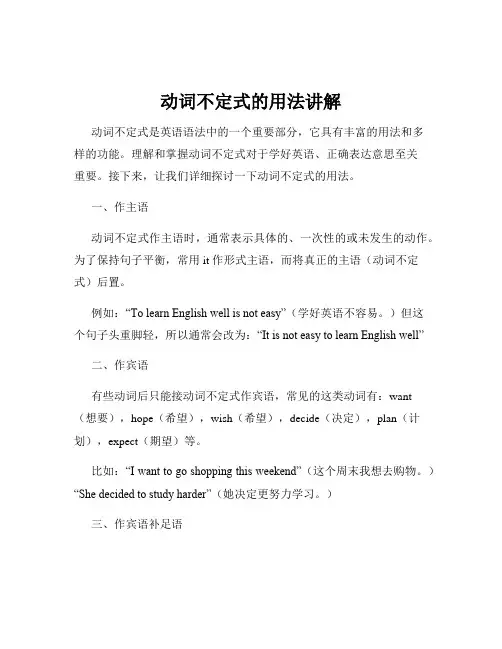
动词不定式的用法讲解动词不定式是英语语法中的一个重要部分,它具有丰富的用法和多样的功能。
理解和掌握动词不定式对于学好英语、正确表达意思至关重要。
接下来,让我们详细探讨一下动词不定式的用法。
一、作主语动词不定式作主语时,通常表示具体的、一次性的或未发生的动作。
为了保持句子平衡,常用 it 作形式主语,而将真正的主语(动词不定式)后置。
例如:“To learn English well is not easy”(学好英语不容易。
)但这个句子头重脚轻,所以通常会改为:“It is not easy to learn English well”二、作宾语有些动词后只能接动词不定式作宾语,常见的这类动词有:want(想要),hope(希望),wish(希望),decide(决定),plan(计划),expect(期望)等。
比如:“I want to go shopping this weekend”(这个周末我想去购物。
)“She decided to study harder”(她决定更努力学习。
)三、作宾语补足语某些动词后需要用动词不定式作宾语补足语,常见的有:ask(要求),tell(告诉),want(想要),allow(允许),encourage(鼓励)等。
例如:“My mother asks me to clean my room every day”(我妈妈每天要求我打扫房间。
)“The teacher encourages us to speak English more”(老师鼓励我们多说英语。
)四、作定语动词不定式作定语时,通常放在被修饰词之后,与被修饰词之间存在逻辑上的动宾关系。
例如:“I have a lot of work to do”(我有很多工作要做。
)“There is no time to waste”(没有时间可以浪费。
)五、作状语1、目的状语动词不定式可以作目的状语,表示某一动作或行为的目的。
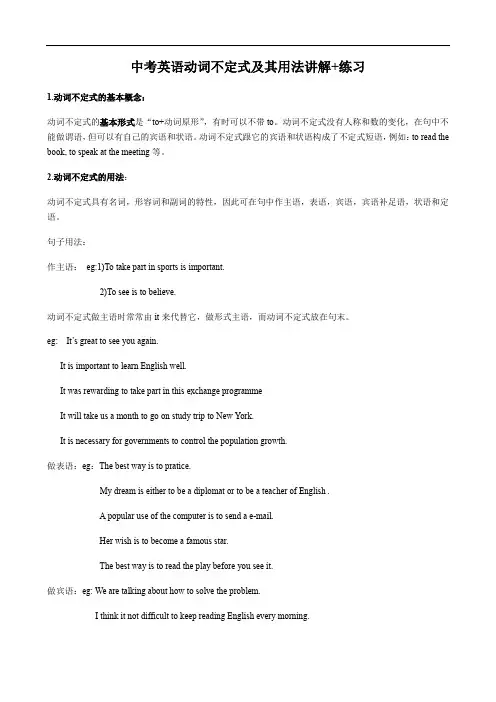
中考英语动词不定式及其用法讲解+练习1.动词不定式的基本概念:动词不定式的基本形式是“to+动词原形”,有时可以不带to。
动词不定式没有人称和数的变化,在句中不能做谓语,但可以有自己的宾语和状语。
动词不定式跟它的宾语和状语构成了不定式短语,例如:to read the book, to speak at the meeting等。
2.动词不定式的用法:动词不定式具有名词,形容词和副词的特性,因此可在句中作主语,表语,宾语,宾语补足语,状语和定语。
句子用法:作主语:eg:1)To take part in sports is important.2)To see is to believe.动词不定式做主语时常常由it来代替它,做形式主语,而动词不定式放在句末。
eg: It’s great to see you again.It is important to learn English well.It was rewarding to take part in this exchange programmeIt will take us a month to go on study trip to New York.It is necessary for governments to control the population growth.做表语:eg:The best way is to pratice.My dream is either to be a diplomat or to be a teacher of English .A popular use of the computer is to send a e-mail.Her wish is to become a famous star.The best way is to read the play before you see it.做宾语:eg: We are talking about how to solve the problem.I think it not difficult to keep reading English every morning.做宾补:eg: We all expect him to win the contest.Our teacher told us to listen carefully in class.注意:感官动词,或使役动词+宾语+无to的不定式Is Jack in the library ?Maybe I saw him go out with some books just now.Let those in need understand that we will go all out to help them.做定语:Liu Yang is the Chinese woman astronaut to enter the space.You are the last one to win the price.In the future , human will have less work to do.Why don’t you go out to play Rose?I’m afraid I can’t . I have a lot of homework to do.做状语:动词不定式做状语可以修饰动词,一般在句中做原因,目的和结果状语,动词不定式做状语可单独放在句首,句中或句末。
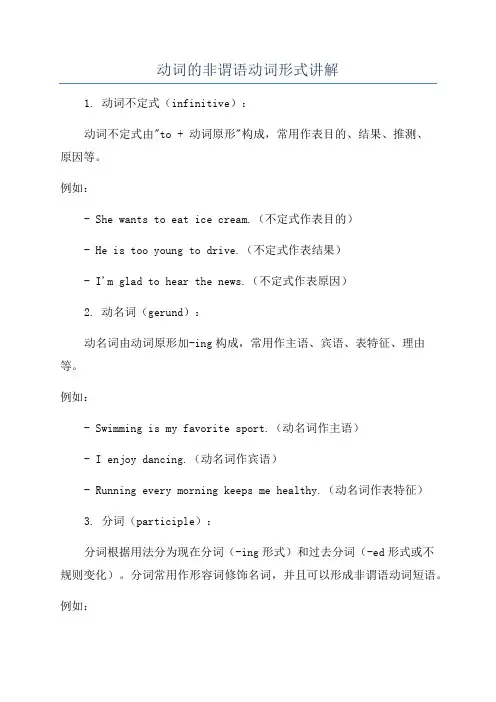
动词的非谓语动词形式讲解
1. 动词不定式(infinitive):
动词不定式由"to + 动词原形"构成,常用作表目的、结果、推测、
原因等。
例如:
- She wants to eat ice cream.(不定式作表目的)
- He is too young to drive.(不定式作表结果)
- I'm glad to hear the news.(不定式作表原因)
2. 动名词(gerund):
动名词由动词原形加-ing构成,常用作主语、宾语、表特征、理由等。
例如:
- Swimming is my favorite sport.(动名词作主语)
- I enjoy dancing.(动名词作宾语)
- Running every morning keeps me healthy.(动名词作表特征)
3. 分词(participle):
分词根据用法分为现在分词(-ing形式)和过去分词(-ed形式或不
规则变化)。
分词常用作形容词修饰名词,并且可以形成非谓语动词短语。
例如:
- The running cat escaped from the dog.(现在分词作形容词)- The broken window needs to be fixed.(过去分词作形容词)- Having finished his homework, he went to bed.(现在分词短语作时间状语)
总之,动词的非谓语动词形式可以用于句子中的不同成分,通过表达不同的含义,丰富语言表达。
动词不定式的用法解说一、动词不定式:组成:to+ 动词原形(to不过不定式符号,没存心义)动词不定式作主语较长时,常用it 作形式主语,而将真实的主语放在句末。
+is/was+ 形容词+(forsb.)+ 动词不定式TolearnEnglishwell isuseful.=It ’suseful tolearnEnglishwell. 学好英语是实用的。
Toprotectenvironment isimportantforus.=It’simportant forus toprotectenvironment. 关于我们来说保护环境是很重要的。
2.Itis/was+kind/good/nice/clever+ofsb.+ 动词不定式It’sverykindofyou tohelpme. 你帮助我真是太好啦。
It’sverycleverofyou todolikethat . 你那样做真的太聪慧啦。
3.It takes(took,will take)sb.sometimetodosomething.(做某事花销某人时间 )isagoodideatodosth.作宾语常有的跟不定式作宾语的动词有:wanttodosth.decidetodosth.hopetodosth.plantodosth.offertodosth.agreetodosth.learntodosth trytodosth prefertodosthpromise todosth.needto dosth.expect todosth.2.主语+find/think+it+形容词+(forsb.)+todoIfindi teasytoreadEnglisheveryday.我发现每日读英语和简单的。
Hefelt ithardtosleep.他感觉很难入眠。
Ithinkitveryint erestingtolearnEnglish.我以为学英语很风趣。
08动词不定式的用法第一部分动词不定式的用法知识梳理一、构成:to + 动词原形二、作用:作除谓语外的任何成分三、动词不定式的作用四.、不定式的特殊用法①使役动词和感官动词后跟动词不定式作宾语补足语,须省略to。
此类动词有:一感(feel)、二听(hear, listen to)、三让(let, make, have)、四看(look at, see, watch, notice)、五帮(help)。
变为被动语态时,省略的to 则要加上。
①动词不定式的否定形式是not to do,其被动形式为to be done。
►Our teacher asked us not to swim in the river alone. 我们老师要求我们不要独自一人在河里游泳。
①常接"疑问词+带to的不定式"的动词有teach, show, tell, learn, find out, decide, know, forget等。
►My mother taught me how to cook yesterday. 昨天我妈妈教我如何做饭。
第二部分动词不定式的用法专项训练(含解析)一、单项选择1.I want ________ more about the world.A.to learn B.learning C.learn D.learn to2.I really love sports. Can you tell me how ________ badminton?A.play B.to play C.playing D.plays3.—What do we need ___________ for dinner ?—Some vegetables and cakes.A.buy B.to buy C.buying D.buys4.Let ________ and ________ friends.A.he; I am B.he; I are C.him; me are D.him; me be5.Playing sports makes him ________ happy.A.to feel B.feels C.feel D.feeling6.It’s sunny and windy. Let’s________ kites together.A.flies B.fly C.to fly D.flying7.—What do you think of the two dresses?—I think this new dress is better. It makes ________ pretty.A.her look B.her looks C.she look D.she looks8.— Your cousin Peter must be good at English.— Yes, I often hear him ________ English in the morning.A.read B.reads C.reading D.to read9._________ Yushan Park, please turn left after you ________ the bus stop.A.To arrive; pass B.Arrive at; past C.Get to; past D.To get to; pass10.Every year we see many mums _________ cheongsam(旗袍)at the school gate to wish their children good luck at the college entrance examination.A.wear B.wearing C.to wear D.wore11.My teacher often makes me ________ my deskmate with his study.A.to help B.helps C.helping D.help12.Harry Potter (《哈利波特》) is ________ interesting book. I want ________ one.A.a; to buy B.an; to buy C.the; buys D.an; buy13.I want ________ a teacher and let’s ________ good friends.A.be; be B.to be; to be C.be; to be D.to be; be14.—-Let us help him ________ his homework. —Thank you.A.does B.doing C.with do D.do15.Miss Gao wants _________ his housework before supper.A.finishes B.finish C.to finish D.finishing16.We need ________ healthy.A.stay B.stays C.to stay D.staying17.It takes me three hours ________ the new house.A.clean B.to clean C.cleaning D.cleaned18.Everyone ________ here. Let’s ________ our class.A.is, to begin B.are, begin C.is, beginning D.is, begin19.I like ________. I would like ________ shopping with my good friend this weekend.A.shop, going B.shopping, to go C.shopping, going D.to shop, going20.— Kate, did you watch the science lesson from the Tiangong space station?— Yes, of course! It makes us ________ very excited.A.feel B.to feel C.feeling D.feels二、完成句子21.马克的妈妈请他带她参观他的学校。
英语不定式的讲解
英语不定式是一种动词形式,由动词原形加上“to”构成。
不定
式可以用作动词、名词、形容词的一部分。
1. 作动词:
不定式通常用作其他动词的宾语。
例如:
- I want to eat pizza.(我想吃比萨饼。
)
- She loves to dance.(她喜欢跳舞。
)
2. 作名词:
不定式可以用作名词的主语、宾语、表语或补语。
例如:
- To learn is important for success.(学习对于成功很重要。
)
- His dream is to become a doctor.(他的梦想是成为一名医生。
)
3. 作形容词:
不定式可以用作形容词修饰名词。
例如:
- He has a book to read.(他有一本书可以读。
)
- I need a pen to write with.(我需要一支可以写字的笔。
)
4. 不定式短语:
不定式短语由动词不定式加上副词、介词或名词构成,并在句子中作特定的语法功能。
例如:
- He went to the store to buy some groceries.(他去商店买了些食品杂货。
)
- She studied hard to pass the exam.(她努力学习以便通过考试。
)
总而言之,不定式在句子中具有多种不同的语法功能,可以作动词、名词或形容词的一部分,并且有不定式短语的形式。
在使用不定式时,需要注意不同的语法规则和用法。
动词不定式短语讲解概述说明以及解释1. 引言1.1 概述:在英语语法中,动词不定式短语是一种由动词不定式构成的短语结构。
它是一个重要的语法概念,在英语表达中经常被使用。
动词不定式短语具有丰富的用法和功能,可以用来表达目的、原因、条件等。
1.2 文章结构:本文将对动词不定式短语进行详细讲解,并围绕以下几个方面展开:什么是动词不定式短语、其结构是怎样的以及它的功能与用法;同时还将介绍动词不定式短语的特点,包括定义和特性、形式与构成规则以及示例和应用场景;最后,我们将解释动词不定式短语的分类和类型,包括根据主动与被动分为两类类型、根据动作性质分为三类类型以及其他相关分类和类型简介。
1.3 目的:撰写本文旨在提供对动词不定式短语的全面认识和理解。
通过深入讲解其概念、特点和分类等方面内容,帮助读者掌握并正确运用这一重要的语法知识点。
同时,展望动词不定式短语在英语学习和实际应用中的重要性,并对其未来的应用前景进行展望。
请问还有什么需要补充的吗?2. 动词不定式短语讲解:2.1 什么是动词不定式短语动词不定式短语是由动词不定式和其相关的修饰成分所构成的一个独立的结构。
它通常在句子中作为名词、形容词或副词的补足语,用来表达一些特定的意义或功能。
2.2 动词不定式短语的结构一个典型的动词不定式短语由一个基本形式的动词不定式(包括“to”+动词原形)作为核心,以及可能出现的修饰成分组成。
修饰成分可以是副词、介词短语、形容词、名词等。
2.3 动词不定式短语的功能与用法动词不定式短语可以用来表达多种功能和意义。
以下是几个常见用法:1) 作主语:例如,“To study is important for students.”(学习对于学生很重要)2) 作宾语:例如,“I want to go to the park.”(我想去公园)3) 作表语:例如,“Her dream is to become a doctor.”(她的梦想是当医生)4) 作宾补:例如,“They made him sign the contract.”(他们让他签署了合同)5) 作定语:例如,“I need a book to read.”(我需要一本书来阅读)6) 作状语:例如,“He went to the library to study.”(他去图书馆学习)动词不定式短语还可以用于被动结构、条件句、目的状语从句以及其他复杂句型中。
动词不定式作定语的例句嘿,大家好!今天咱们来聊聊动词不定式作定语这事儿。
说实话,这个话题听上去可能有点儿枯燥,但是放在实际生活里,其实是特别有趣的。
不信?来看看吧。
1. 动词不定式是什么1.1 什么是动词不定式动词不定式其实就是“to + 动词原形”这种形式,比如说“to eat”、“to play”、“to read”。
简单点儿理解,就是一种还没被时间或人称“绑架”的动词形态。
1.2 动词不定式的作用在句子里,动词不定式不仅能做主语、宾语,还可以用来修饰名词,这就是我们今天要聊的重点——动词不定式作定语!2. 动词不定式作定语的妙用2.1 给名词加点儿料咱们说,动词不定式当作定语用,就是给名词添点儿“料”,让名词的意思更加丰富、具体。
比如:A book to read这里的“to read”就是修饰“book”的。
意思就是“一个值得读的书”,是不是一下子就清楚多了?A place to relax“to relax”修饰“place”,意思是“一个可以放松的地方”。
这话一说,心里立马想象出一个美丽的度假胜地,是不是?2.2 形象的表达动词不定式作定语可以让你的表达更加生动和具体。
试试这个:A task to complete 。
这里“to complete”让人一听就知道,这个任务有个明确的目标,那就是完成它。
听上去是不是更有干劲儿了?3. 实用的例句分享3.1 生活中的例子让咱们把这些概念放到实际生活中去看:A movie to watch想象一下你在找电影看,这时候你看到“a movie to watch”,这不就是给你推荐了一部电影嘛!你心里会觉得,这部电影肯定值得一看!A person to meet有时候,咱们会遇到特别的人,这时你可以说“a person to meet”,这就意味着,这个人很有价值,值得认识。
3.2 职场中的应用在工作场合,动词不定式作定语也能大显身手:A plan to implement 。
动词不定式的用法讲义动词不定式是英语语法中的一个重要部分,它具有丰富的用法和多样的功能。
下面让我们一起来详细了解一下动词不定式的各种用法。
一、动词不定式的形式动词不定式的基本形式是“to +动词原形”,例如“to study”“to play”。
但在一些情况下,to 会被省略,我们后面会详细讲到。
二、动词不定式作主语动词不定式可以用作句子的主语,表示一个具体的、将要发生的动作。
例如:“To learn a foreign language well is not easy”(学好一门外语不容易。
)但需要注意的是,为了避免句子头重脚轻,通常会使用形式主语 it ,将真正的主语动词不定式后置,变成“It is not easy to learn a foreign language well”三、动词不定式作宾语很多动词后面可以接动词不定式作宾语,常见的有:want(想要),hope(希望),decide(决定),plan(计划),expect(期望)等。
例如:“I want to go shopping this weekend”(这个周末我想去购物。
)四、动词不定式作宾语补足语有些动词后面会接宾语和动词不定式作宾语补足语,常见的这类动词有:ask(要求),tell(告诉),allow(允许),enable(使能够)等。
例如:“The teacher asked us to finish the homework on time”(老师要求我们按时完成作业。
)五、动词不定式作定语动词不定式可以用来修饰名词或代词,作定语。
例如:“I have a lot of work to do”(我有很多工作要做。
)这里的“to do”就修饰“work”,表示“要做的工作”。
六、动词不定式作状语1、目的状语动词不定式可以作目的状语,表示某个动作的目的。
例如:“He came here to see me”(他来这里是为了看我。
一动词不定式:to + 动词原形1.基本用法:可在句中作主、宾、表、定、状、补。
1)作主语To get up early is a good habit.It's so nice to hear your voice.(it 为形式主语)It is important for us to learn English well.It’s silly of you to do such a thing.How to improve our English is still a problem.2) 作宾语We all hope to see you.They found it hard to learn Chinese. (it 为形式宾语)I do not know what to do next. (疑问词+ 不定式)He asked me how to improve English.(疑问词+不定式)3)作表语①一般情况My work is to clean the room every day.His dream is to be a doctor.The question is how to put it into practice. 问题是怎样把它付诸实施。
He seemed to have known the news.②如果主语是不定式,则表语也用不定式。
例如:To see is to believe.Seeing is believing.③作表语的不定式有时可省略符号to:这时主语部分必须含有动词do,而作表语的不定式则解释do 的精确意思。
All I did was (to) give him a little help.What we want to do now is (to) have a rest.4)作定语①不定式作定语时,被修饰的名词常为它的逻辑宾语。
不定式与该名词存在逻辑上的动宾关系。
I have some clothes to wash.(后置定语)He has something important to tell you.如果不定式是不及物动词,后面应有必要的介词。
Give me a pen to write with.I need a warm room to live in.②逻辑上的主谓关系。
He was the first teacher to come.I need a box to hold my books.Is there anyone to answer my question?He was the last student to have left the classroom .( 不定式完成式)③逻辑上的同位关系。
Everyone has the right to speak at the meeting= Everyone has the right that he may/ can speak at the meeting.Do keep your promise to write to me.= Do keep your promise that you will write to me.5)作状语①作目的状语He will go to the station to meet his friend.I often read China Daily in order to (或so as to ) improve my English.(in order to可放在句首;so as to 只能放在句中)。
I come here only to say good-bye to you.②作结果状语I hurried to his house only to find he was out.He is (not) old enough to join the army.It’s too late to play basketball.He was so angry as to be unable to speak.③作原因状语I was surprised to see him here.They were pleased to hear the good news.I am glad to meet you .④在形容词后作状语This question is easy to answer.6)作补语He wants his son to become a lawyer.She encouraged me to try again.They persuaded him to give up smoking.They believe him to be writing a new book .他们认为他正在写一本新书。
He wanted the letter to be typed at once .The letter was wanted to be typed at once.(主补)注:有些动词后跟不带to 的不定式作宾语补足语。
常见的有:①感官动词feel, hear ,see, watch, notice , observe②使役动词let, make, have③ help :help sb. do…… 或help sb. to do…… 两种说法均可。
I often hear him sing this song.The boss made the workers work 12 hours a day.当此类句子改为被动语态时,要补上to.He is often heard to sing this song.The workers were made to work 12 hours a day.☆在think, find, consider, discover等动词后常用to be +adj.结构作宾补,有时to be 可省略。
We all think/ consider/ find/ discover him (to be) kind and honest. 我们都认为/发现他既善良又诚实。
2.不定式的时态/方式1) 一般式:有时与谓语动词表示的动作同时发生,有时发生在谓语动词的动作之后。
(to do )He seems to know this.I hope to see you again. = I hope that I'll see you again.我希望再见到你。
2) 进行式:表示动作正在进行,与谓语动词表示的动作同时发生。
(to be doing )He seems to be eating something.3) 完成式:表示的动作发生在谓语动词表示的动作之前。
(to have done)I'm sorry to have given you so much trouble.He seems to have caught a cold.4) 完成进行式:(to have been doing)She is known to have been working on the problem for many years.He pretended to have been studying.3. 动词不定式的否定式:not to doTell him not to shut the window.She pretended not to see me when I passed by.例1)Tell him ___ the window.A. to shut notB. not to shutC. to not shutD. not shut答案:B。
tell sb. to do sth 的否定形式为tell sb. not to do sth..例2) She pretended ___ me when I passed by.A.not to seeB. not seeingC. to not seeD.having not seen答案:A。
pretend 后应接不定式。
其否定形式为pretend not to do sth.。
例3)Mrs. Smith warned her daughter ___ after drinking.A. never to driveB. to never driverC. never drivingD. never drive答案:A。
warn sb. to do sth. 的否定形式为warn sb.not to do sth. 此处用的是否定词never. 例4) The boy wanted to ride his bicycle in the street,but his mother told him ____.A. not toB. not to doC. not do itD. do not to答案:A。
not to 为not to do it 的省略形式。
例5) The patient was warned ___ oily food after the operation.A. to eat noB. eating notC. not to eatD. not eating答案:C。
此处为warn sb. to do 的被动否定形式,即be warned not to do。
4.动词不定式的省略1)不定式在使役动词let, have, make和感官动词see, watch, notice , observe, hear, smell, feel, find 等后作宾补时,省略to。
help 可带to,也可不带to →help sb (to) do sth。
2) Why not 后面接不带to 的不定式。
常用来表建议。
Why not have a break?3)but和except:but/except前的部分出现实义动词do时,其后面出现的动词不定式可以不带to。
He wants to believe anything but to take the medicine.比较:but前有实义动词do时,but后的不定式需要省去to. 如:Last night I did nothing but (to )watch TV.He does everything except (to) work.4) 由and, or或than连接的两个不定式,第二个不定式的to 可以省去。